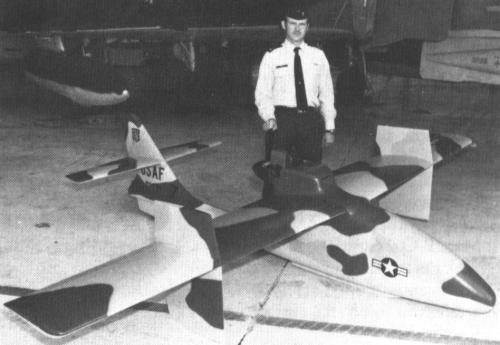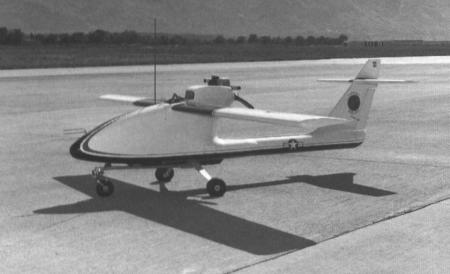USAF FDL BQM-106 Teleplane
Beginning in 1975, the USAF's Flight Dynamics Laboratory (FDL) designed and built the FDL-33 series of small experimental RPVs under the designation XBQM-106, sometimes called Teleplane. The Teleplane vehicles tested several wing, nose, tail and engine configurations, and evaluated RPV equipment and technologies like a fluidic autopilot, seeker/warhead options for expendable strike missions, light-weight composite construction and low-observables (stealth) technology.
 |
| Photo: USAF |
| XBQM-106 (early configuration) |
The XBQM-106 vehicles were relatively small drones powered by a low-power piston engine driving a pusher propeller. The first vehicles had a McCulloch MC-101 engine, but most of the later ones used a Herbrandson Dyad 220 two-cylinder two-stroke engine. The fuselage was of pod-and-boom design, and the whole airframe was of non-metallic construction. The Teleplane was started from a pneumatic catapult launcher and recovered by a normal skid landing. It had a radio-command guidance system for full control from the ground, but could also fly autonomously on autopilot. The downlink transmitted telemetry data and video imagery from a nose-mounted TV camera.
 |
| Photo: Dave Gossett |
| XBQM-106 (Teledyne Ryan design) |
At least 23 XBQM-106 vehicles in 13 different variants were built, including at least two designed by Teledyne Ryan. In January 1984, new designations were allocated to then current configurations of the FDL-33 vehicle. The XBQM-106A was built by Digital Design Inc., and had a cylindrical tail boom, a high wing of slightly reduced span and a T-tail. The XBQM-106A also had a parachute system which could be used as an alternate recovery method. The XBQM-106B was an FDL-modified XBQM-106A, which lacked the latter's parachute landing option and had a tailboom with an elliptical section. It was used for pilot proficiency training. The XBQM-106C was an experimental modification of the XBQM-106B with a new tail, which had the horizontal stabilizer relocated to the mid of the vertical fin. The whole XBQM-106 test and development program ended in early 1986.
Specifications
Note: Data given by several sources show slight variations. Figures given below may therefore be inaccurate!
Data for XBQM-106, XBQM-106A:
| XBQM-106 | XBQM-106A | |
|---|---|---|
| Length | 2.74 m (9 ft) | 3.07 m (10 ft 1 in) |
| Wingspan | 3.7 - 4.9 m (12 - 16 ft) | 3.63 m (11 ft 11 in) |
| Height | 0.66 m (2 ft 2 in) | 0.84 m (2 ft 9 in) |
| Weight | 34 - 59 kg (75 - 130 lb) | 106 kg (235 lb) |
| Speed | ? | 185 km/h (100 kts) |
| Ceiling | ? | 3000 m (10000 ft) |
| Endurance | ? | 5 hours |
| Propulsion | McCulloch MC-101 single-cyl. two-stroke piston engine | Herbrandson Dyad 220 two-cyl. two-stroke piston engine; 13.5 kW (18 hp) |
Main Sources
[1] Kenneth Munson: "World Unmanned Aircraft", Jane's, 1988
[2] William Wagner, William P. Sloan: "Fireflies and other UAVs", Midland Publishing, 1992
[3] Department of Defense Missile Nomenclature Records
Back to Current Designations Of U.S. Unmanned Military Aerospace Vehicles
Back to Directory of U.S. Military Rockets and Missiles
Last Updated: 24 December 2002